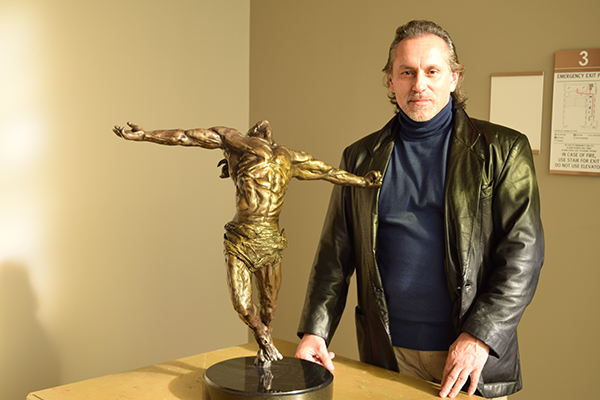
WILLIAMSBURG — A statue depicting Jesus Christ’s victory over death, created by an artist inspired by the movie “The Passion of the Christ,” is generating plenty of buzz at its new home at the Emmaus Center.
“Invictus,” a 26-inch-high bronze statue, is artist Lou Sandoval’s vision of a risen Jesus — his body was battered by the beatings he endured at the hands of the Romans, and the holes from the Crucifixion visible on his hands and feet — in his moment of triumph over death.
The statue depicts Jesus not on the cross or lovingly bestowing a blessing on a New Testament figure, but with his arms reaching back as he seemingly propels his body forward.
“I always wondered why in the representations of Christ we’ve seen Jesus as the lamb. I’ve never seen a representation of him as a warrior king overcoming the wounds, overcoming the bleeding,” Sandoval said. “I wanted to create a trophy. His victory over death is the greatest victory mankind has ever known.”
The Emmaus Center, the recently opened arts and cultural venue of the Diocese of Brooklyn, commissioned the statue from Sandoval, who has created a limited edition of 50 “Invictus” statues. One statue will remain at the center.
The exact location where it will be put on permanent display in the building is yet to be determined, said Msgr. Jamie Gigantiello, Emmaus Center chairman of the board.
There is also talk of having the statue go on a tour of churches in the diocese, although no plans have yet been made.
The statue could be the first of many works the Emmaus Center commissions from artists. The partnerships would work to serve the interests of the venue as well as the artists, Msgr. Gigantiello said.
“We wanted to do something obviously to raise funds for the center and also to get artists you’re interested [about] in some way in the center. We would commission new works of art that we can distribute throughout the center,” he said.
Two other statues will be offered as gifts –– one to the Vatican and the other to Jim Caviezel, the actor who portrayed Jesus Christ in “The Passion of the Christ.”
The remaining statues will be available for sale for $10,000 each. Sandoval said he has already heard from two potential buyers and is hoping that churches in the diocese express an interest in purchasing them.
Sandoval, who lives in Gallup, New Mexico, sold the original statue to a New Mexico businessman who keeps it in a special room in his house, built an altar-type of structure around it, and told the artist he has no plans to ever resell it.
“Invictus” is actually a replica of a statue Sandoval created after he saw “The Passion of the Christ,” the 2004 film directed by Mel Gibson.
“I couldn’t get that movie out of my head,” said Sandoval, who is a member of the Actor’s Studio and counts Al Pacino and Sylvester Stallone as his cinematic heroes. “And then I just got this vision in my head of an image of Jesus I wanted to create. I wanted it to be a moment of triumph. He teaches us that if we get through the pain, we can go on to bigger and better things.”
The original statue, which stands 42-inches high, took five months to create.
Sandoval created the statue using a time-honored method called the “lost wax” process. It is a multi-step process involving creating a mold made of wax and then pouring melted bronze into the mold, letting the bronze harden and then removing the wax to reveal the bronze statue inside.
Sandoval first sketched the statue on paper and then made a model for his statue out of clay. He then brought it to a foundry in Burbank, California that artists use and had the wax mold made.
He firmly believes the Holy Spirit guided him during the creative process. “Sometimes, you have to get out of your own way,” he said.
Craig Tubiolo, executive director of the Emmaus Center, heard about the statue through a friend in the arts and after discussing it with Msgr, Gigantiello, reached out to Sandoval and commissioned a new statue.
Msgr. Gigantiello said he was struck by the uniqueness of Sandoval’s work.
“You see the expression in the statue of the suffering of Christ –– that the pain was so unbearable –– but yet it also almost looks like a dancer. He looks like he’s bending over backwards to offer himself to God. It’s an example to all of us. We should bend to the will of God, too,” he said.
